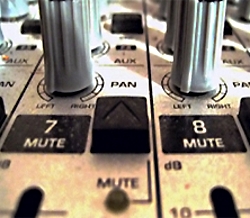How many mute mistakes have you made?
You wouldn’t think one little button with one simple function would cause many problems but it does!
Time after time, people fall victim to its simplicity. Now you can find out how to minimize your mute mishaps.
The first mute mistake I ever made was when I was working at radio station 89.5 WFCI – Indy’s New Rock Alternative. 95 percent of the music was on CD with 5 percent being on vinyl. The CD players were set to stop after a track was played. As a DJ, that was great because I never had to bother with fading or muting a CD channel on the mixing board.
But then came the Eurythmics.
Their album was on vinyl and it was the first cut on the A-side.
The song lyrics ended and the last 20 seconds were instrumental. I announced the standard segue with the radio station call letters, the name of the song I’d just played and then did the pre-sell for the next three-song set. Somewhere along the way, I also started the next song.
I turned off my microphone and then something caught my attention. The song on the air didn’t sound right. It was a new song, the format was alternative rock (when it was up and coming in the mid 1990s), and I’d never heard it before. Even with all that being said, I knew something was wrong. Out of the corner of my eye, I saw the record player still spinning.
The second track on the vinyl album was playing at the same time as the one in the CD player. I’d been so used to the auto-stop of the CD player that I’d forgotten to mute the record player!
What is muting?
The idea of muting is simple. Looking at each channel, your mixer will either have a mute or an on/off button. For simplicity, I’ll reference this as the mute button. Using the mute button, you silence that channel completely. This includes anything going to the monitors.
There are also assignable group/VCA mutes. In this case, you can route multiple channels to one control for volume and mute-ability.
Getting technical in 3…2…1…
A VCA-enabled mixer works differently than a non-VCA mixer. Without getting overly technical, the difference between the two is the point in which the “group control” takes control of the individual channels.
A VCA-enabled mixer has a VCA (voltage controlled amplifier) on each channel that pulls the signal before the channel’s fader and controls the signal separately from the fader. A non-VCA-enabled mixer gets the signal after it goes through the channel fader.
The more components a signal has to traverse, the more noise that can be introduced into the signal. Therefore, the VCA-enabled mixer doesn’t require the signal to go through the additional fader component of the channel.





















